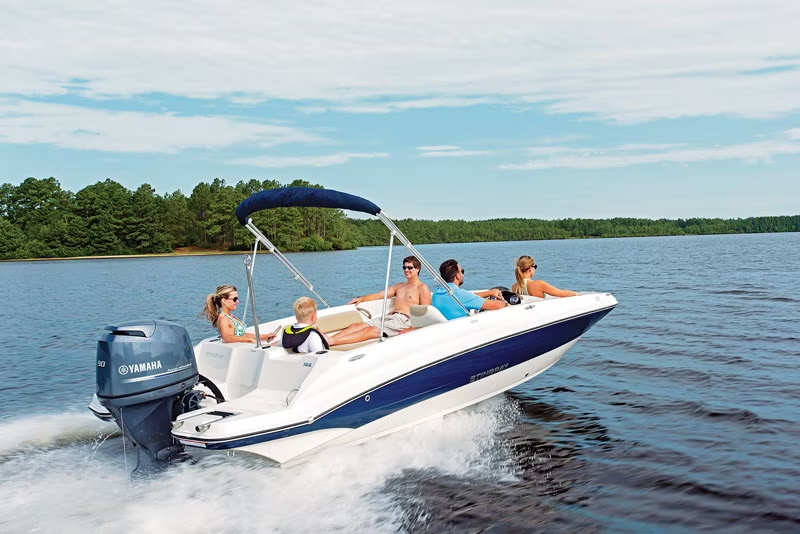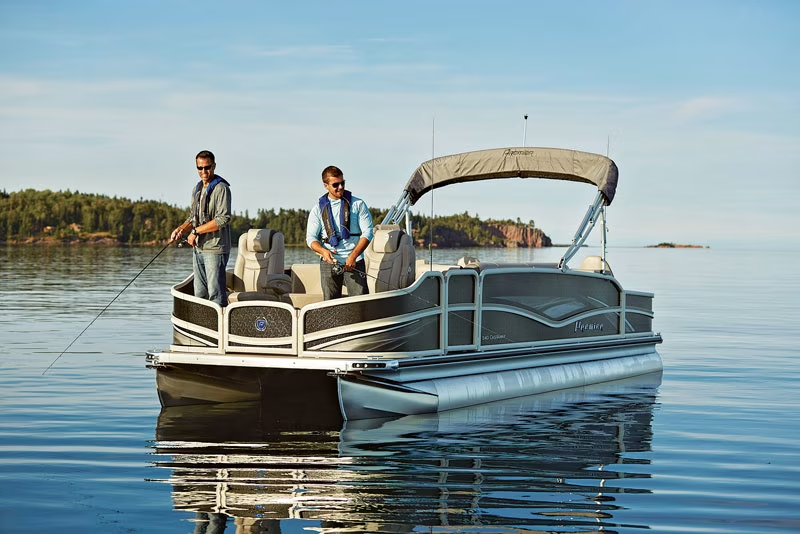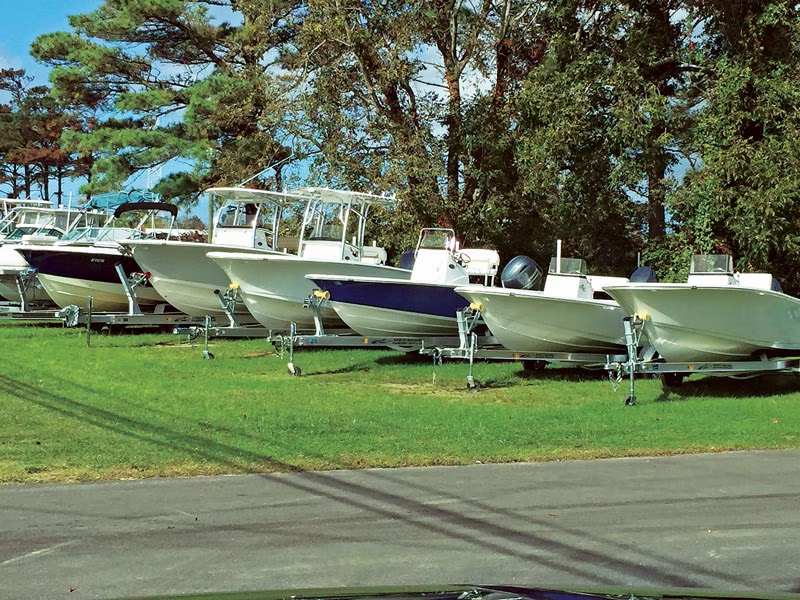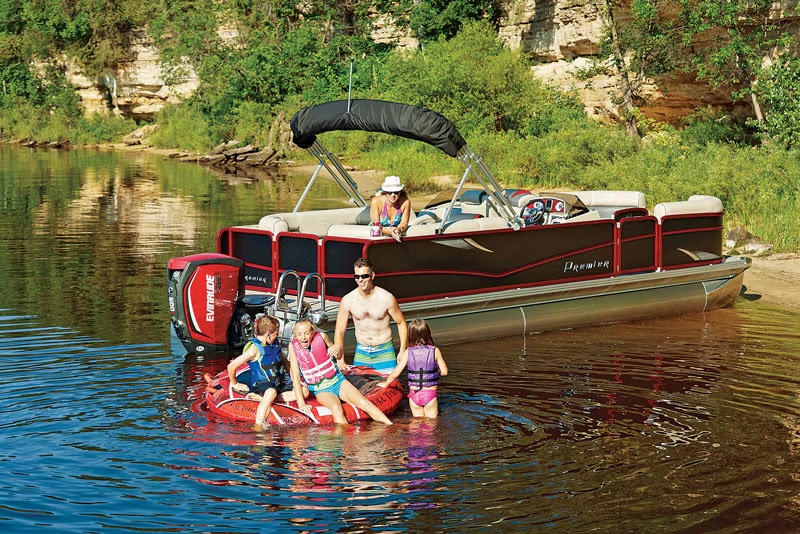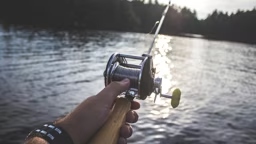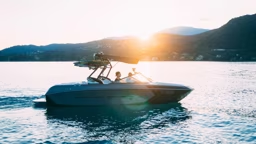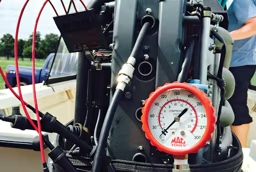By John Tiger
Perhaps you’re new cabin owners and your dock’s looking awfully bare – or you’re replacing an aging hull. Chances are you’ll need a multipurpose craft, something that will carry your family and guests comfortably, yet still fishes, skis, plays and cruises well. Perhaps you already have a boat like that, and you’re looking to specialize: a purpose-built fishing boat or a tournament-style ski machine. What about a “classic woody” for those evening cruises around the shoreline? If you’re starting from zero, you may need multiple boats; often, families have a pontoon for cruising, a ski boat and/or personal watercraft for the kids, and a fishing craft for early-morning angling.
That new boat smell
Though it makes more sense financially to buy used (a new boat loses around 30% of its purchase price the day it leaves the showroom), there’s nothing like being the first to own a new rig. But if you’re going to spend all that coin, get what you want and buy it right: Buy at the right time; there are great deals in the off season and during boat shows to entice buyers to buy. Cash back, “free” options and upgrades, financing incentives, extra warranty, free storage and sometimes even a free trailer are commonly used as bait for new boat buyers. Don’t be afraid to spend quality time with dealers going through all the deals. Pay careful attention to how the dealer treats you throughout the negotiating process. If you’re uncomfortable, chances are it’s not a good deal and possibly a good indicator of how that dealer will make you feel later on – when service is needed. The dealer’s representation and reputation are at least as important as the boat/engine brand and reputation. This is a very, very important lesson to learn. Boat dealers are not in any way like car dealers. In today’s world, it doesn’t matter where you bought your car because any dealer will service it with a smile. Not so with boat dealers; even today, they are still very territorial and will make no bones about servicing customers who bought from them first, and all others have to wait. That’s vital in a short boating season!
Buying used
Buying used is a great alternative to dropping big coin for new. Used boats come with warranties too, just like used cars. It’s all in who you buy from and the deal you make. What helps ease worries is that today, the great majority of boats and engines are well built and reliable, even many years later. Says Kim Hubbard, owner of Centerville Marina (centervillemarina.com) in Chesapeake, Va.: “We broker boats for our good customers, but we insist on a $150, multiple-point check before we will stand behind their boat. After all, it’s us the new buyer will come to if something goes wrong, so we do what’s necessary to minimize problems before the boat is even listed with us.” However, speak with local dealers before you consider anything with a lot of years on it; many dealers won’t work on rigs older than a decade.
Tips for buying used:
- Check message boards on older models and ask lots of questions about durability, quality and reliability.
- Don’t buy a rig that’s more than a decade old. Quality has come a long way in the past 10 years or so, and rigs built in the 2000s will be more reliable and easier to maintain.
- Buy only one-owner rigs; you’re more likely to get a more complete and accurate service history.
- Buy only from a dealer, and at least ask for a one-year warranty. This is a sticky point, and one ripe for debate. Everyone knows the story about “that boat owned by an older couple who never used it.”
- Stick with well-known brands that are still in business. Top-of-the-line brands like Cobalt, Crownline, Chaparral and Sea Ray can be expensive but are always reliably good boats. Popular brands like Larson, Glastron, Stingray, Rinker and similar others can also be good values.
- Same with motors: be brand conscious. If you’re looking at stern drive boats, Mercury (MerCruiser) and Volvo Penta are the only brands to consider. However, excellent outboards include all the modern brands: Mercury, Evinrude/Johnson, Honda, Yamaha, Suzuki and Tohatsu. If you stick to engines made 10 years ago and newer, you’ll be buying reliability and newer technology.
- Try to find boats and engines that have documented usage hours. Typically, anything over 400 or so hours should be considered carefully; the lower the usage hours the better.
- Maintenance and upkeep records are also very important. No records may well mean shoddy (or no) maintenance. Stay away.
- It’s a good idea to spend a little extra to hire a marine surveyor to go over the boat carefully prior to purchase. The survey will reveal any anomalies with the boat, and let you know whether you’re getting a good boat at a good price or simply buying somebody else’s headache. Surveyors can be found at the Society of Accredited Marine Surveyors (SAMS) and the National Association of Marine Surveyors (NAMS) websites.
- If you are the kind of person who must have everything perfect, and you’re not equipped nor inclined to handle repairs, then you should buy a new or very lightly used late-model boat, from a dealer who will stand behind it.
- If you are good mechanically, have extra time on your hands, and enjoy projects, you’ll love having a used boat. If you simply can’t afford a new boat, but don’t have the time or skill to take on projects from time-to-time, then we recommend you buy a used boat that is as simple as possible. The fewer systems a boat has, the fewer things that can go wrong.
Repowering
Most times, the boat outlasts the powerplant. If your boat’s still seaworthy and you feel no need to replace it, consider repowering. Outboard hulls are great for this, and there are many large outboard dealers who specialize in repowers. Rob Gina, owner of Boatwrench (boatwrench.com) in Orlando, Fla., notes: “We repower hundreds of outboard and stern drive hulls every year. It’s a viable option considering the cost of a new boat; today’s outboards and new stern drives are technologically light years ahead of models just 15 years old, so it’s almost like having a new boat.”



